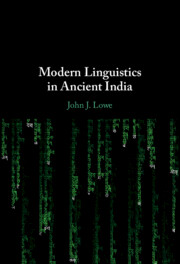Refine search
Actions for selected content:
29 results
4 - Potnia of the Labyrinth, Initiation of the King, and the Triple Sacrifice
-
- Book:
- Myth, Ritual, and Society in Mycenaean Anatolia
- Published online:
- 18 July 2025
- Print publication:
- 07 August 2025, pp 131-161
-
- Chapter
- Export citation
2 - Mycenaean and Vedic Sacrificial Posts
-
- Book:
- Myth, Ritual, and Society in Mycenaean Anatolia
- Published online:
- 18 July 2025
- Print publication:
- 07 August 2025, pp 47-66
-
- Chapter
- Export citation
6 - Nart Saga, Indo-Iranian Twins, and Dioscurias
-
- Book:
- Myth, Ritual, and Society in Mycenaean Anatolia
- Published online:
- 18 July 2025
- Print publication:
- 07 August 2025, pp 194-237
-
- Chapter
- Export citation
7 - Golden Fleeces
-
- Book:
- Myth, Ritual, and Society in Mycenaean Anatolia
- Published online:
- 18 July 2025
- Print publication:
- 07 August 2025, pp 238-272
-
- Chapter
- Export citation
5 - Mitannian and Anatolian Triads
-
- Book:
- Myth, Ritual, and Society in Mycenaean Anatolia
- Published online:
- 18 July 2025
- Print publication:
- 07 August 2025, pp 162-193
-
- Chapter
- Export citation
1 - A Mycenaean Ritual and Its Cult Language
-
- Book:
- Myth, Ritual, and Society in Mycenaean Anatolia
- Published online:
- 18 July 2025
- Print publication:
- 07 August 2025, pp 8-46
-
- Chapter
- Export citation
3 - Mycenaean Leaders in the Context of Indo-European and Indo-Iranian Society and Ritual
-
- Book:
- Myth, Ritual, and Society in Mycenaean Anatolia
- Published online:
- 18 July 2025
- Print publication:
- 07 August 2025, pp 67-130
-
- Chapter
- Export citation
1 - Introduction
- from Part I
-
- Book:
- Representants and International Orders
- Published online:
- 15 May 2025
- Print publication:
- 08 May 2025, pp 3-25
-
- Chapter
- Export citation
Why comment? Interlingual commentaries in early modern India
-
- Journal:
- Journal of the Royal Asiatic Society / Volume 35 / Issue 1 / January 2025
- Published online by Cambridge University Press:
- 16 December 2024, pp. 197-221
- Print publication:
- January 2025
-
- Article
-
- You have access
- Open access
- HTML
- Export citation
5 - Aeolian Patronymics and the Mycenaean Hekwetai
- from Part I - Aeolian and Aeolic
-
- Book:
- Aeolic and Aeolians
- Published online:
- 21 November 2024
- Print publication:
- 21 November 2024, pp 88-141
-
- Chapter
- Export citation
8 - Algeria’s Language Regime
- from Part II - Dependent Relationships
-
-
- Book:
- States of Language Policy
- Published online:
- 14 November 2024
- Print publication:
- 21 November 2024, pp 150-168
-
- Chapter
- Export citation
4 - Mycenaean Dialects and Despótēs
- from Part I - Aeolian and Aeolic
-
- Book:
- Aeolic and Aeolians
- Published online:
- 21 November 2024
- Print publication:
- 21 November 2024, pp 69-87
-
- Chapter
- Export citation

Modern Linguistics in Ancient India
-
- Published online:
- 14 March 2024
- Print publication:
- 21 March 2024
Chapter 27 - The German Study of India and Buddhism
- from IV - Life, Language, and the Ancient World
-
-
- Book:
- Wagner in Context
- Published online:
- 14 March 2024
- Print publication:
- 14 March 2024, pp 267-274
-
- Chapter
- Export citation
2 - Courtly Mutualism: The Emperor’s Jeweler Shantidas Jhaveri, 1628–58
-
- Book:
- Bankrolling Empire
- Published online:
- 16 November 2023
- Print publication:
- 30 November 2023, pp 71-108
-
- Chapter
- Export citation
5 - Extending Canonical Morphotactic Criteria to Composite Rules
-
- Book:
- Morphotactics
- Published online:
- 24 November 2022
- Print publication:
- 08 December 2022, pp 141-158
-
- Chapter
- Export citation
3 - Dependent Rules and Carrier Rules
-
- Book:
- Morphotactics
- Published online:
- 24 November 2022
- Print publication:
- 08 December 2022, pp 83-112
-
- Chapter
- Export citation
Chapter 3 - Scriptural Sources
- from Part I - Background and Context
-
- Book:
- Reconstructing Early Buddhism
- Published online:
- 13 October 2022
- Print publication:
- 20 October 2022, pp 51-80
-
- Chapter
- Export citation
1 - Introduction: Situating India
-
- Book:
- India before Europe
- Published online:
- 15 September 2022
- Print publication:
- 08 September 2022, pp 1-27
-
- Chapter
- Export citation
5 - Sixteenth-Century North India: Empire Reformulated
-
- Book:
- India before Europe
- Published online:
- 15 September 2022
- Print publication:
- 08 September 2022, pp 136-186
-
- Chapter
- Export citation
